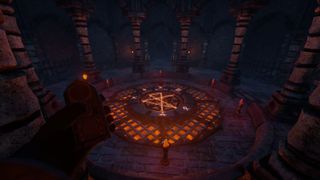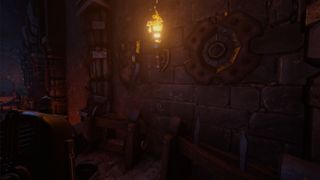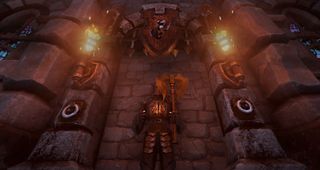Two players co-operate to solve linked escape rooms in We Were Here Too
Stop, collaborate and listen: We Were Here Too demonstrates the power of two-player puzzling.

"You said it was a mace, right?"
"Yeah, it has lots of spikes all over it and it's cylindrical."
"That one didn't work. You're sure it was spiky? I have one that's studded and one that's spiky."
"Yeah it's got lots of little pyramid shapes all over."
"You said cylindrical?"
"Yeah, a cylinder with spikes on it."
"Oh, I found it! This one is studded. I also have one that's got real spikes on it."
The biggest gaming news, reviews and hardware deals
Keep up to date with the most important stories and the best deals, as picked by the PC Gamer team.
"Those are totally real spikes!"
Who’s on first?
This exchange is one of many like it that a friend and I have while playing We Were Here Too. Armed only with walkie-talkies, we navigate the abandoned halls of Castle Rock, separated in space but united in confusion. Each room is a puzzle that neither player has enough information to solve alone. We have to communicate our surroundings to one another and discover what the puzzle actually is before attempting to solve it.
After successfully shouting words at one another in each room a new door opens, leading us to our next set of escape rooms. It's a method of co-op play that is engaging in a different way to playing together on a couch or hacking-and-slashing in the same space. We Were Here Too, just like its free predecessor We Were Here, demands that we pay attention to one another and co-operate like never before.

I was lucky enough to have a willing guinea pig buddy for We Were Here Too, but you can also host or join a session to be matched with a random partner. The only way to coordinate is over the in-game walkie-talkies so you'll need a compatible microphone for your PC. There's no text chat to fall back on.
The puzzles in We Were Here Too aren't inherently complex. They typically involve matching items or interacting with objects in sequence. The challenge is our ability to decipher one another's jargon. Although we have our experience playing the previous game and 18 years of friendship under our belt, miscommunication is impossible to avoid. "It looks like an hourglass," I might say, looking at a rectangle with a pinch in the center. In her room, my partner looks at eight symbols, two of which look a bit like an hourglass. "So is it two triangles touching?" She might say. "Not triangles. It's corset-shaped, maybe?"
We quickly develop a system for running about and staying alive, even though we never do end up with a reliable vocabulary for cataloging short swords.
That's the real challenge in We Were Here Too. Whether you're describing abstract symbols, stained glass windows, or a selection of weaponry, one player has to use the most specific language possible to help their partner choose between several options. After playing together twice in order to see both sides of each puzzle, we settled on two examples that best display the possibilities of asymmetrical multiplayer.
The real puzzle is you
In a room with a moving wall intent on crushing me, I find four suits of armor holding weapons, standing beneath four different heraldries. My partner's room also has four knights and accompanying animal heralds, but is full of random weapons. In the center of her room is a wheel which she spins to keep the wall in my room from crushing me. As I attempt to describe the nuances of two different battle axes, she runs back and forth handing weapons to the correct suits of armor while assuring that I don't become a sandwich. Although we discover our complete ignorance of medieval period weapons, we did thoroughly enjoy the puzzle both times.

The weaponry puzzle forces us to communicate and simultaneously manage the environment. Unlike a couple other puzzles which only test the speed we shout descriptions with a time limit, this challenge gave us all the time we needed, provided we could balance priorities. Any time the walls begin closing in the music grows dire, warning my partner to run back to her wheel. We quickly develop a system for running about and staying alive, even though we never do end up with a reliable vocabulary for cataloging short swords.
The other most successful puzzle in We Were Here Too involves what appears to be a chess board. I look at a miniature board on which they have one movable piece and several stationary obstacles. My partner stands on a life-size board surrounded by the same obstacles but cannot see my piece. Instead, she sees two knights who move in tandem with me. Both partially blind to the board, we navigate the two knights, both moving in sync with my invisible piece, to the end of the board while avoiding obstacles.
The chess puzzle is a relief from the high stress of potential wall-crushing. Not only is it more thoughtfully paced, but the puzzle itself would be a test of logic skills even without the separation of players. Rather than testing our ability to describe, it tests our ability to give and receive orders. It forces us to co-operate, not just collaborate.

The armory and the chess board showcase the best of puzzle-solving and asymmetrical co-op. Some less successful rooms pose puzzles with quickly determined solutions, placing the burden on execution. The labyrinth, in which one player directs the other through a maze under a time limit, is particularly frustrating. By contrast the armory puzzle, although technically performed under a time limit, is more enticing. The task at hand (give weapons to the appropriate knight) is easy to comprehend, but the puzzle itself (co-operatively determining accurate language to describe each weapon) is not fully solved until the moment we complete the puzzle. It forces us to continue thinking throughout, rather than an being an easy task only made hard by a more merciless ticking clock.
Not every puzzle in We Were Here Too is a shining beacon of the potential of asymmetrical co-op, but its slower and more thoughtful puzzles give me hope for more games that make players become the puzzles. Apart from Keep Talking and Nobody Explodes, the asymmetrical co-op style of communication as puzzle hasn't been widely explored. Even after almost being squished, my co-op buddy and I are both eagerly awaiting more games that present us with a similar challenge.

Lauren has been writing for PC Gamer since she went hunting for the cryptid Dark Souls fashion police in 2017. She accepted her role as Associate Editor in 2021, now serving as self-appointed chief cozy games and farmlife sim enjoyer. Her career originally began in game development and she remains fascinated by how games tick in the modding and speedrunning scenes. She likes long fantasy books, longer RPGs, can't stop playing co-op survival crafting games, and has spent a number of hours she refuses to count building houses in The Sims games for over 20 years.
Most Popular

